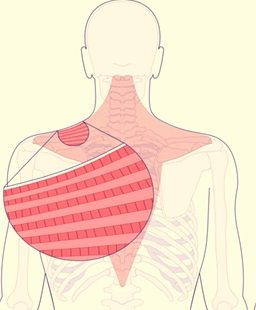
Myofascial Pain
MUSCLE PAIN
Myalgia is muscle pain or pain of muscular origin, irrespective of cause. There are two major types of non-inflammatory myalgia that are commonly diagnosed; MPS & Fibromyalgia.
Myofascial pain syndrome (MPS), is muscle pain that can occur after doing a lot of intense exercise, especially if the muscles aren't used to it. This pain happens because the muscles are stressed and not getting enough energy to do their job properly. This can lead to soreness and discomfort in the muscles, especially if you've done a lot of heavy or unfamiliar exercise.

- These trigger points can cause pain directly where they are located and also make you feel pain in other areas of the body that aren’t directly affected.
- This referred pain happens because the trigger points release chemicals that send pain signals to different parts of the body.
- Better Localization: Ultrasound can help accurately locate MTrPs by providing a detailed image of the muscles and any trigger points within them.
- Improved Procedures: With precise localization, treatments such as injections or manual therapy can be more targeted and effective.
- Safety and Efficacy: By improving the accuracy of identifying MTrPs, ultrasound can help make these interventions safer and more effective.
Non-specific causes of Chronic myalgia:
Vitamin B12 deficiency- nerve dysfunction
Iron deficiency in muscle occurs when muscle ferritin is depleted. Symptoms such as chronic tiredness, unusual fatigue with exercise, and coldness begin with the first stage of iron loss.
Vitamin D deficiency is associated with musculoskeletal pain, loss of type II muscle fibres, and proximal muscle atrophy.
The following pictures show MTrPs and their referral patterns causing headache, neck and shoulder pain, upper back pain.

The following Myofascial trigger points are common causes of leg pain.

GOALS OF TREATMENT OF MYOFASCIAL PAIN
- Requires the inactivation of (Myofascial trigger points) MTrPs
- The restoration of normal muscle length
- The elimination or correction of the factors that created or perpetuated the trigger points in the first place.
TREATMENT OPTIONS
1. MANUAL THERAPY
2. TRIGGER POINT RELEASE INJECTIONS:
Often chronic MTrPs are difficult to treat and can be inactivated by inserting a needle into the trigger zone or point (Dry needling); done by a Pain Specialist under Ultrasound image guidance.
This can be done with injection of local anaesthetic.
Properly done, a local twitch response will occur, often with a momentary reproduction of referred pain, and then the taut band will relax and tenderness will diminish or disappear.
In chronic, resistant cases, Botox injections can also be considered.

3. PROLOTHERAPY
Dextrose Prolotherapy is presumed to work by several mechanisms including a direct, an osmotic, and inflammatory growth effect. Dextrose injections below a 10% solution directly stimulate proliferation of cells and tissue without causing an inflammatory reaction.
4. ACUPUNCTURE
5. PHYSICAL CONDITIONING
Once trigger point pain is reduced and perpetuating factors are addressed, a physical conditioning programme can strengthen muscle, increase endurance, and perhaps reduce the possibility of reactivating the trigger points.
 +91 8248827895 |
+91 8248827895 |  absolutevitalhealth@gmail.com
absolutevitalhealth@gmail.com
 Joint Pain
Joint Pain